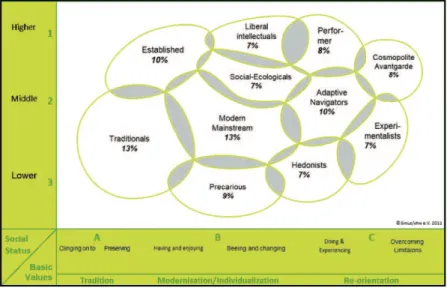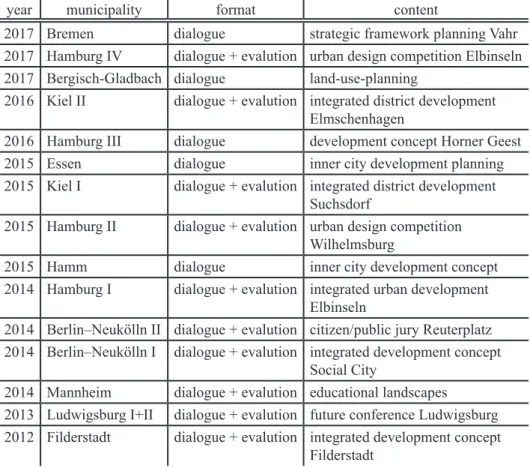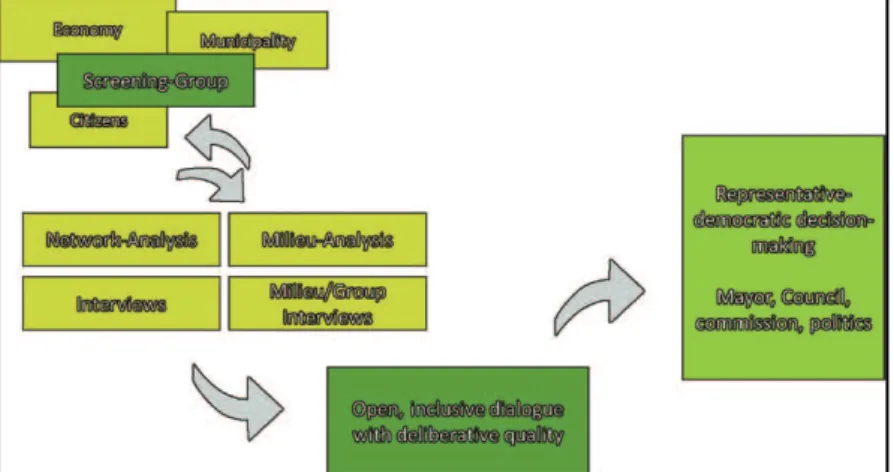¯¯¯¯¯¯¯¯¯¯¯¯¯¯¯¯¯¯¯¯¯¯¯¯¯¯¯¯¯¯¯¯¯¯¯¯¯¯¯¯¯¯¯¯¯¯¯¯¯¯¯¯¯¯¯¯¯¯¯¯¯¯¯¯¯¯¯¯¯¯¯¯¯¯¯¯¯¯¯¯¯¯¯¯¯¯¯¯¯¯¯¯¯¯¯¯¯¯¯¯¯¯¯¯¯¯¯¯¯¯¯¯¯¯¯¯¯¯¯¯¯¯¯¯
Challenges for Civic Participation and Local Democratic Processes in Urban
Development
German Experiences Christian Höcke
23Abstract
The focus of this article is about challenges and experiences with dialogue oriented civic participation in urban development processes in Germany. The article builds on the implementation and evaluation of several participatory processes, which were realised in eleven German cities since 2012. In Germany, civic participation has become an integral part of planning practice in most communal authorities in the past decades and especially in the last fifteen years. Many methods for participatory planning processes have been developed and municipal authorities set up their own guidelines for good participation.
Unfortunately, within the context of post-democratic trends, public participation in local politics has received the same criticism from political scientists, as has the representative democracy. In many cases, instead of being an effective instrument for feedback between state and citizens, it reproduces social injustice. The article analyses the challenges for civic participation regarding its democratic legitimization and implementation practice within urban planning processes between top-down oriented governmental actions and local bottom-up contexts. It ends with a proposal of how civic participation could be improved and societal inclusion strengthened in local democratic processes, and to increase the effectivity and acceptance of public planning.
Keywords: civic participation, deliberation, urban planning, local democracy 23 vhw – Federal Association for Housing and Urban Development e.V., Germany;
choecke@vhw.de
I. Introduction
In the past few years, representative democracy in Western European countries is seen as being in crisis (Crouch, C. 2008) or as experiencing fundamental change on its way to a diverse democracy
(Bertelsmann Stiftung 2014).
In Germany and elsewhere in Europe, this can be observed on the one hand by an ongoing decline of mainstream political parties, a decrease of voting participation in federal but especially local elections and in particular, by
¯¯¯¯¯¯¯¯¯¯¯¯¯¯¯¯¯¯¯¯¯¯¯¯¯¯¯¯¯¯¯¯¯¯¯¯¯¯¯¯¯¯¯¯¯¯¯¯¯¯¯¯¯¯¯¯¯¯¯¯¯¯¯¯¯¯¯¯¯¯¯¯¯¯¯¯¯¯¯¯¯¯¯¯¯¯¯¯¯¯¯¯¯¯¯¯¯¯¯¯¯¯¯¯¯¯¯¯¯¯¯¯¯¯¯¯¯¯¯¯¯¯¯¯¯¯¯¯¯
growing societal divide or political asymmetry, which can be observed by a socio–economic gap between political engaged and non-engaged citizens (Jörke, D. 2011). On the other hand, direct democracy and civic participation have grown in importance. As an adjunct to representative democracy, it is hoped that those participatory forms of political engagement will strengthen local communities, raise the political interest and democratic competence of citizens and increase trust in political institutions, renewing the basis of the representative democratic system (Merkel, W. 2015).
From a planning perspective, participation on a local level shall increase the acceptance of planning processes, avoide bad planning and investments, and hence improve the effectivity of the process itself.
Certainly, civic participation is not new and belongs to the common repertoire of public planning bodies. It has received broad attention by many scholars since the last decade on national (see e.g. Vetter, A. 2008; Beck, K. – Zieckow, J. 2011; Selle, K. 2013) and international levels with the formulation of documents like the European Charter on Participatory Democracy (ECTP 2016). In Germany, civic participation is regulated by laws
such as Land Use Planning, Regional Planning Procedures and Environmental Impact Assessments and is mandatory since the 1970s.
However, civic participation also plays an important role within several federal urban assistance programmes, where integrated urban development approaches are practised. Examples of this are the Social City Programme (Programm Soziale Stadt), Small Cities and Municipalities (Programm Kleinere Städte und Gemeinden), the Active City and Town Centres Programme (Aktive Stadt- und Ortsteilzentren) and the Urban Regeneration East and West Programme (Stadtumbau Ost und West).
II. Challenges for Participation
Within planning practice it can be observed that the quality of civic participation and its objectives vary considerably among different processes. From an executive municipal perspective, this is due to several reasons such as different professional experiences, the availability of financial and human resources and the scope for actions of public bodies. Civic participation often takes place in an urban climate, which is increasingly troubled by conflicts about economisation of urban development processes,
¯¯¯¯¯¯¯¯¯¯¯¯¯¯¯¯¯¯¯¯¯¯¯¯¯¯¯¯¯¯¯¯¯¯¯¯¯¯¯¯¯¯¯¯¯¯¯¯¯¯¯¯¯¯¯¯¯¯¯¯¯¯¯¯¯¯¯¯¯¯¯¯¯¯¯¯¯¯¯¯¯¯¯¯¯¯¯¯¯¯¯¯¯¯¯¯¯¯¯¯¯¯¯¯¯¯¯¯¯¯¯¯¯¯¯¯¯¯¯¯¯¯¯¯¯¯¯¯¯
which makes it even more challenging to arbitrate between different interests of stakeholders, citizens included. Hence, planning reliability can be put under stress, observed for instance in the planning process of the Stuttgart train station ‘Stuttgart 21’ and the unsuccessful revitalization of the old inner city airport Tempelhof in Berlin, the ‘Tempelhofer Feld’.
Public authorities often need new methodology and forms of cooperation and communication between themselves and external stakeholders. Within integrated urban development processes in Germany it can be observed that administrative organisation often hinders cooperation. Due to its structure, administrative departments tend to operate separately with a tendency to compete on power and human and financial resources. Moreover, top- down oriented civic participation often fails to address the interests of the public, due to one-dimensional agenda-setting or by merely distributing information rather than offering open and transparent deliberative processes where the participants can actually influence decisions. Hence, these and other challenges to the processes bear the risk of resulting in a loss of quality and, as Selle stated, becoming
‘Particitainment’ (Selle, K. 2011
p. 3.), rather than strengthening democratic diversity.
To deal with these and other issues challenging civic participation, more than 100 municipalities in Germany developed guidelines to allow for better implementation and quality of civic participation processes.
However, these differ widely in content, institutionalization and binding character.
With closer scrutiny of the citizens involved, it can be observed that civic participation is mainly dominated and therefore biased by the middle class which risks making civic participation even a contributor to the loss of political equality (Kuder, T. – Ritzi, C. 2013). Participation requires communicative skills, which are unequally distributed in the society. A civic participation process, which in the preparation of its format and agenda does not take that into account, often results in the exclusion of certain groups.
These groups are mainly those who live under severe or precarious circumstances and already mistrust the most in public and political institutions (Kreckel, R. 2004;
vhw – Bundesverband für Wohnen und Stadtentwicklung 2015).
To better visualise that demographic and societal
¯¯¯¯¯¯¯¯¯¯¯¯¯¯¯¯¯¯¯¯¯¯¯¯¯¯¯¯¯¯¯¯¯¯¯¯¯¯¯¯¯¯¯¯¯¯¯¯¯¯¯¯¯¯¯¯¯¯¯¯¯¯¯¯¯¯¯¯¯¯¯¯¯¯¯¯¯¯¯¯¯¯¯¯¯¯¯¯¯¯¯¯¯¯¯¯¯¯¯¯¯¯¯¯¯¯¯¯¯¯¯¯¯¯¯¯¯¯¯¯¯¯¯¯¯¯¯¯¯
imbalance, the vhw has applied the
Sinus-Milieu-research tool in it’s work within participatory urban development processes (Figure 1).
Figure 1: The Sinus-Milieus in Germany Source: Sinus/vhw 2011
As a combination of socio–
demographic data and normative value orientation, the milieu tool offers a true-to-live image of the sociocultural diversity in the society (Sinus 2015). Milieus bundle up the knowledge about attitudes, demands and behavioural patterns in different areas, from social cohesion to housing, the use of public space, education, mobility, communication patterns as well as civic participation.
With the possibility to transfer the milieus into a GIS, that knowledge can be localised and applied for urban development processes.
The qualitative and quantitative
knowledge of milieus is continuously broadened by quantitative as well as qualitative surveys (e.g. vhw – Bundesverband für Wohnen und Stadtentwicklung 2015).
Asking about the satisfaction with civic participation within those surveys, the feeling about being welcome at civic participation processes or if people think their concerns are playing a significant role, the outcomes show a clear imbalance. It is especially significant between those milieus with a rather low social-status like the so-called Precarious and the Hedonists on the one side, and the modern middle and higher classes like the Established,
¯¯¯¯¯¯¯¯¯¯¯¯¯¯¯¯¯¯¯¯¯¯¯¯¯¯¯¯¯¯¯¯¯¯¯¯¯¯¯¯¯¯¯¯¯¯¯¯¯¯¯¯¯¯¯¯¯¯¯¯¯¯¯¯¯¯¯¯¯¯¯¯¯¯¯¯¯¯¯¯¯¯¯¯¯¯¯¯¯¯¯¯¯¯¯¯¯¯¯¯¯¯¯¯¯¯¯¯¯¯¯¯¯¯¯¯¯¯¯¯¯¯¯¯¯¯¯¯¯
the Liberal intellectuals and the Adaptive Navigators on the other side (Figure 2). Therefore, due to varying personal interests, living conditions and communication
skills among participating groups, a specialized approach for each group or milieu is needed to foster inclusion.
A B
Figure 2: Representative national survey TREND 2015, n=2095 Source: vhw – Bundesverband für Wohnen und Stadtentwicklung 2015
III. Approaches to Improve the Quality of Civic Participation
The following paragraphs will build on practical experiences gained within 16 participatory processes conducted in 13 cities in Germany like Berlin, Bremen, Essen, Hamburg, Kiel and Ludwigsburg (Table 1). These processes where carried out within the vhw urban network since 2010, which aimed at strengthening local democracy through citizen oriented integrated urban development, called ‘Städtenetzwerk’. The aim within that project was to improve
the quality, justice and inclusion of civic participation processes and to access a new basis for legitimisation. The participatory procedures included a scientific monitoring and evaluation by the Helmut Schmidt University in Hamburg. The thematic urban development topics in which the participatory processes were applied, have been neighbourhood development, the social city programme, education, inner city development and land use planning. The main steps within these processes will be explained in the following paragraphs.
¯¯¯¯¯¯¯¯¯¯¯¯¯¯¯¯¯¯¯¯¯¯¯¯¯¯¯¯¯¯¯¯¯¯¯¯¯¯¯¯¯¯¯¯¯¯¯¯¯¯¯¯¯¯¯¯¯¯¯¯¯¯¯¯¯¯¯¯¯¯¯¯¯¯¯¯¯¯¯¯¯¯¯¯¯¯¯¯¯¯¯¯¯¯¯¯¯¯¯¯¯¯¯¯¯¯¯¯¯¯¯¯¯¯¯¯¯¯¯¯¯¯¯¯¯¯¯¯¯
year municipality format content
2017 Bremen dialogue strategic framework planning Vahr 2017 Hamburg IV dialogue + evalution urban design competition Elbinseln 2017 Bergisch-Gladbach dialogue land-use-planning
2016 Kiel II dialogue + evalution integrated district development Elmschenhagen
2016 Hamburg III dialogue development concept Horner Geest 2015 Essen dialogue inner city development planning 2015 Kiel I dialogue + evalution integrated district development
Suchsdorf
2015 Hamburg II dialogue + evalution urban design competition Wilhelmsburg
2015 Hamm dialogue inner city development concept 2014 Hamburg I dialogue + evalution integrated urban development
Elbinseln
2014 Berlin–Neukölln II dialogue + evalution citizen/public jury Reuterplatz 2014 Berlin–Neukölln I dialogue + evalution integrated development concept
Social City
2014 Mannheim dialogue + evalution educational landscapes
2013 Ludwigsburg I+II dialogue + evalution future conference Ludwigsburg 2012 Filderstadt dialogue + evalution integrated development concept
Filderstadt
Table 1: Realized civic participation processes within the vhw city network Source: compilation of the author
III.1. First step: Generating Knowledge
The first step of all processes was to gain knowledge of the needs of the citizens regarding their residential environment, their values and attitudes, the identification of potential and existing conflicts and networks of different stakeholders related to the specific integrated planning topic before public debate begins. Another aim hereby was to raise awareness
about the planned participatory process. Different methods have been applied to gain that knowledge, such as data and milieu-analyses, network- analyses, milieu-based interviews as well as expert interviews. For hard to reach milieus, or specific stakeholder groups, focus-group interviews have been carried out, related to the topic of the planning process (e.g. in Berlin, Essen, Hamburg, Mannheim).
The outcomes were anonymised and captured in a mood board,
¯¯¯¯¯¯¯¯¯¯¯¯¯¯¯¯¯¯¯¯¯¯¯¯¯¯¯¯¯¯¯¯¯¯¯¯¯¯¯¯¯¯¯¯¯¯¯¯¯¯¯¯¯¯¯¯¯¯¯¯¯¯¯¯¯¯¯¯¯¯¯¯¯¯¯¯¯¯¯¯¯¯¯¯¯¯¯¯¯¯¯¯¯¯¯¯¯¯¯¯¯¯¯¯¯¯¯¯¯¯¯¯¯¯¯¯¯¯¯¯¯¯¯¯¯¯¯¯¯
which allowed to better address and prepare for the specific interests of the citizens within the planning processes agenda. The aim hereby was to improve the willingness to participate by approaching the citizens with their specific interests, while communicating and inviting for the public dialogues. Another important task of that knowledge generation was to identify major concerns of the citizens, which didn’t relate to the main planning topic but would most likely come up within a dialogue. This helped to prepare for those concerns and to find ways to address them by the public administration.
In many processes (e.g.
Essen, Hamburg, Kiel, Mannheim), a screening group had been deployed which consisted of public administration, citizens and/or organised civil society and other local stakeholders which had an important role in the thematic field of the process. The aim of this group was to prepare the participatory process, to pre-discuss the substance and the boundary conditions of the negotiable context, to agree upon the transfer of the participatory outcomes into the representative public institutions and to decide about the specific content and the format of the public deliberation. It was in that way a guarantor for a good process quality and a commitment of the planning authorities for transparency.
III.2. Second Step: Public deliberation
The main part of the whole process was a public debate (or various) with deliberative criteria:
fair and on equal footing based on an exchange of arguments to a procedure, which not only delivers a reliable and effective planning process but also unfolds a positive democratic and societal effect. This had to be ensured on the one hand by a skilled and neutral moderation and milieu-sensible preparation of the topics, which are set to be discussed, to allow everyone to participate and represent his or her interests and therefore the possible inclusion of all societal groups.
Another important part was the agreement with the citizens on how and to what extent their concerns could be realised. This includes the self-commitment of political and administrative institutions involved, to comply or explain why certain issues might or cannot be realised. Therefore, the specific boundaries of the content of a process always should be clear to the citizens involved.
III.3. Third step:
Evaluation
To monitor the quality of the dialogue, an evalution through
¯¯¯¯¯¯¯¯¯¯¯¯¯¯¯¯¯¯¯¯¯¯¯¯¯¯¯¯¯¯¯¯¯¯¯¯¯¯¯¯¯¯¯¯¯¯¯¯¯¯¯¯¯¯¯¯¯¯¯¯¯¯¯¯¯¯¯¯¯¯¯¯¯¯¯¯¯¯¯¯¯¯¯¯¯¯¯¯¯¯¯¯¯¯¯¯¯¯¯¯¯¯¯¯¯¯¯¯¯¯¯¯¯¯¯¯¯¯¯¯¯¯¯¯¯¯¯¯¯
questionnaires and interviews had been carried out at most processes.
The guiding principles for the evaluation of the deliberative quality, were as follows:
⊕ Did all societal groups/
Milieus been take part in the process?
⊕ Did the participants feel they were being taking seriously?
⊕ Was everyone empowered to bring opinions?
⊕ Did the procedure treat all participants equally?
⊕ Was the discussion factual?
Did everyone have a chance to be heard?
⊕ Did the procedure produce tangible results?
In addition, four main criteria for the evaluation have applied (Schaal, G. – Ritzi, C. 2012):
1. the inclusion of all societal groups, the ability to express their concerns and the reduction of the middle-class bias;
2. the internal and external efficacy which indicates the self-assessment of the citizens involved to be political competent (internal efficacy) and to be able, to actively take part at the decision making process (external efficacy);
3. the procedural quality which ensures equal rights for everyone to speak and vote;
4. the epistemic quality which stands for a fair and topic- oriented argumentation the availability of all relevant information, and that all participants recognise each other as equals.
Figure 3: Applied process scheme Source: vhw
¯¯¯¯¯¯¯¯¯¯¯¯¯¯¯¯¯¯¯¯¯¯¯¯¯¯¯¯¯¯¯¯¯¯¯¯¯¯¯¯¯¯¯¯¯¯¯¯¯¯¯¯¯¯¯¯¯¯¯¯¯¯¯¯¯¯¯¯¯¯¯¯¯¯¯¯¯¯¯¯¯¯¯¯¯¯¯¯¯¯¯¯¯¯¯¯¯¯¯¯¯¯¯¯¯¯¯¯¯¯¯¯¯¯¯¯¯¯¯¯¯¯¯¯¯¯¯¯¯
IV. Conclusions
In most processes carried out following the above principles for participation (Figure 3), the deliberative quality and inclusion had been improved for those taking part (Schaal, G. – Ritzi, C. 2013;
2015a; 2015b). However, even though the processes itself showed a raise of trust in the local political and administrative institutions of those who were participating, the medium or long term effect could not be evaluated. Moreover, even though targeted methods of communication to reach certain societal groups have been applied, a deliberative mini-public such as an open public dialogue event is not able to attract all different societal groups or milieus at once.
This, from the perspective of political theory, still results in a lack of legitimisation regarding the decisions and implementation of a possible consensus, which are made there (Schaal, G. 2016;
Kuder, T. 2017). A combination of different decentralized formats like focus-groups, public interventions and others with a targeted approach can, however lower that still reduced but ongoing participatory bias. Nevertheless, open questions remain such as how all the information and concerns collected within a complex deliberative
system consisting of a multiple formats can be brought together and accepted by all participants involved. Political decision makers, however, still expressed their concerns within the evaluation regarding a binding implementation of a participatory process outcome, which still is not in a same way legitimised as the decisions of the representative institutions (Kuder, T. 2016). Therefore, open questions remain, such as how and with whom the results of deliberative participatory processes can be better embedded into the representative system and how the intersections between representative democracy and democratic deliberation can be re-configured.
Besides the need for a solid theoretical framework, the successful realization of such a complex process of civic participation depends on additional factors. To execute good civic participation with a high deliberative quality, which aims to strengthen local democracy, an effective and reliable urban planning processes as well as social cohesion, municipalities require sufficient resources and often professional support. Finally, as long as binding rules regarding quality criteria of deliberative dialogues do not exist, the processes are dependent on a specific attitude
¯¯¯¯¯¯¯¯¯¯¯¯¯¯¯¯¯¯¯¯¯¯¯¯¯¯¯¯¯¯¯¯¯¯¯¯¯¯¯¯¯¯¯¯¯¯¯¯¯¯¯¯¯¯¯¯¯¯¯¯¯¯¯¯¯¯¯¯¯¯¯¯¯¯¯¯¯¯¯¯¯¯¯¯¯¯¯¯¯¯¯¯¯¯¯¯¯¯¯¯¯¯¯¯¯¯¯¯¯¯¯¯¯¯¯¯¯¯¯¯¯¯¯¯¯¯¯¯¯
towards and the willingness to
implement high quality standards by the local decision makers within the municipal authorities.
V. References
Beck, K. – Zieckow, J. 2011: Mehr Bürgerbeteiligung wagen – Wege zur Vitalisierung der Demokratie. – Wiesbaden
Bertelsmann Stifting 2014: Partizipation im Wandel. Unsere Demokratie zwischen Wählen, Mitmachen und Entscheiden. – Gütersloh:
Bertelsmann Stiftung
Crouch, C. 2008: Postdemokratie. – Frankfurt am Main
ECTP 2016: European Charter on Participatory Democracy in Spatial Planning Process. – European Council of Spatial Planners – http://www.ectp-ceu.eu/images/stories/PDF-docs/European%20 Charter%20on%20Participatory%20Democracy%20English-final.
pdf – 2018. 09. 14.
Jörke, D. 2011: Bürgerbeteiligung in der Postdemokratie. – Aus Politik und Zeitgeschichte 1–2.
Kreckel, R. 2004: Politische Soziologie der sozialen Ungleichheit. – Frankfurt a.M – New York.
Kuder, T. 2016: Starke Lokale Demokratie: Leitlinien für eine hochwertige, inklusive Bürgerbeteiligung. – Berlin. – vhw-werkSTADT 08.
Kuder, T. 2017: Bürgerbeteiligung – neu justiert! Fair, informiert und gleichberechtigt zum ‘besseren’ Ergebnis. – Berlin. – vhw- werkSTADT 16.
Kuder, T. – Ritzi, C. 2013: Die Wirkung der Mitwirkung: Dialog im Stresstest. – Dortmund. – RaumPlanung 170.: pp. 16–22.
Merkel, W. 2015: Nur schöner Schein? Demokratische Innovationen in Theorie und Praxis. – Frankfurt am Main.
Schaal, G. 2016: Deliberative Systeme. Unveröffentlichtes Gutachten. – Hamburg – Berlin.
Schaal, G. – Ritzi, C. 2012: Konzept zur Evaluation von Beteiligungsprozessen. Unveröffentlichtes Gutachten. – Berlin Schaal, G. – Ritzi, C. 2013. Evaluationsbericht Filderstadt. – https://
www.filderstadt.de/8d5cbc10b2ef19d8ea3605bc7e4e0051b4b43 09a/3eaf4c63-89ae-f4e9-692a-a8126f589586/tap2_bhC2Gs_dec/
Bewertung%20der%20Buergerbeteiligung%20im%20ISEK- Prozess%202013.pdf – 2018. 09. 14.
¯¯¯¯¯¯¯¯¯¯¯¯¯¯¯¯¯¯¯¯¯¯¯¯¯¯¯¯¯¯¯¯¯¯¯¯¯¯¯¯¯¯¯¯¯¯¯¯¯¯¯¯¯¯¯¯¯¯¯¯¯¯¯¯¯¯¯¯¯¯¯¯¯¯¯¯¯¯¯¯¯¯¯¯¯¯¯¯¯¯¯¯¯¯¯¯¯¯¯¯¯¯¯¯¯¯¯¯¯¯¯¯¯¯¯¯¯¯¯¯¯¯¯¯¯¯¯¯¯
Schaal, G. – Ritzi, C. 2015a: Dialog Bildungslandschaft Neckarstadt–
West. – https://www.vhw.de/fileadmin/user_upload/03_
staedtenetzwerk/nachrichten/Mannheim/PDFs/Evaluationsbericht_
Bildungslandschaft_06_2015.pdf – 2018. 09. 14.
Schaal, G. – Ritzi, C. 2015b: Perspektiven! Miteinander planen für die Elbinseln. – http://www.hamburg.de/contentblob/4486314/a78c2bb 7a4480c7a92912d410a194e50/data/d-evaluationsbericht-bsu.pdf – 2018. 09. 14.
Selle, K. 2011: ‘Particitainment’ oder: Beteiligen wir uns zu Tode? – PNDonline 3.
Selle, K. 2013: Über Bürgerbeteiligung hinaus – Stadtentwicklung als Gemeinschaftsaufgabe? – Analysen und Konzepte. – Detmold.
Sinus 2015: Information on Sinus-Milieus® 2015. – https://www.sinus- institut.de/veroeffentlichungen/downloads/download/information- on-sinus-milieusR/download-file/354/download-a/download/
download-c/Category/ – 2018. 09. 14.
vhw – Bundesverband für Wohnen und Stadtentwicklung 2015:
Sinus/vhw-Trendstudie. Unveröffentlichte repräsentative Befragung.
– Berlin
Vetter, A. 2008: Erfolgsbedingungen lokaler Bürgerbeteiligung. – Wiesbaden



